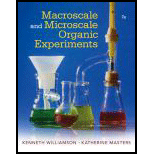
Macroscale and Microscale Organic Experiments
7th Edition
ISBN: 9781305577190
Author: Kenneth L. Williamson, Katherine M. Masters
Publisher: Brooks Cole
expand_more
expand_more
format_list_bulleted
Concept explainers
Textbook Question
Chapter 8, Problem 6Q
Arrange the following in order of increasing
Expert Solution & Answer
Trending nowThis is a popular solution!

Students have asked these similar questions
Using what we have learned in CHEM 2310 and up through class on 1/31, propose a series of reaction
steps to achieve the transformation below. Be sure to show all reagents and intermediates for full
credit. You do not need to draw mechanism arrows, but you do need to include charges where
appropriate. If you do not put your group name, you will get half credit at most.
?
Br
Draw a mechanism for the formation of 2-bromovanillin using bromonium ion as the reactive electrophile.
None
Chapter 8 Solutions
Macroscale and Microscale Organic Experiments
Ch. 8 - Prob. 1QCh. 8 - Prob. 2QCh. 8 - What problem will ensue if the level of the...Ch. 8 - Prob. 4QCh. 8 - Prob. 5QCh. 8 - Arrange the following in order of increasing Rf...Ch. 8 - What will be the result of applying too much...Ch. 8 - Prob. 8QCh. 8 - Prob. 9QCh. 8 - A TLC plate showed two spots with Rf values of...
Knowledge Booster
Learn more about
Need a deep-dive on the concept behind this application? Look no further. Learn more about this topic, chemistry and related others by exploring similar questions and additional content below.Similar questions
- Reagan is doing an atomic absorption experiment that requires a set of zinc standards in the 0.4- 1.6 ppm range. A 1000 ppm Zn solution was prepared by dissolving the necessary amount of solid Zn(NO3)2 in water. The standards can be prepared by diluting the 1000 ppm Zn solution. Table 1 shows one possible set of serial dilutions (stepwise dilution of a solution) that Reagan could perform to make the necessary standards. Solution A was prepared by diluting 5.00 ml of the 1000 ppm Zn standard to 50.00 ml. Solutions C-E are called "calibration standards" because they will be used to calibrate the atomic absorption spectrometer. Table 1: Dilutions of Zinc Solutions Solution Zinc Solution Volume Diluted Solution Concentration used volume (ppm Zn) (mL) (mL) concentration (ppm Zn) Solution concentration A 1000 5.00 50.00 1.00×10² (ppm Zn(NO3)2) 2.90×10² Solution concentration (M Zn(NO3)2 1.53×10-3 B Solution A 5.00 100.00 5.00 C Solution B 5.00 50.00 0.50 7.65×10-6 D Solution B 10.00 50.00…arrow_forwardNonearrow_forwardNonearrow_forward
arrow_back_ios
SEE MORE QUESTIONS
arrow_forward_ios
Recommended textbooks for you
 Chemistry: The Molecular ScienceChemistryISBN:9781285199047Author:John W. Moore, Conrad L. StanitskiPublisher:Cengage Learning
Chemistry: The Molecular ScienceChemistryISBN:9781285199047Author:John W. Moore, Conrad L. StanitskiPublisher:Cengage Learning

Chemistry: The Molecular Science
Chemistry
ISBN:9781285199047
Author:John W. Moore, Conrad L. Stanitski
Publisher:Cengage Learning
IR Spectroscopy; Author: Professor Dave Explains;https://www.youtube.com/watch?v=_TmevMf-Zgs;License: Standard YouTube License, CC-BY